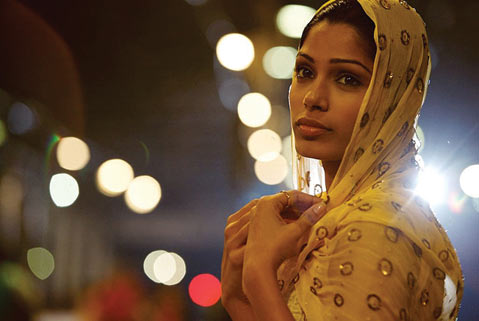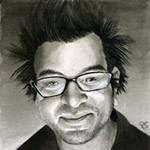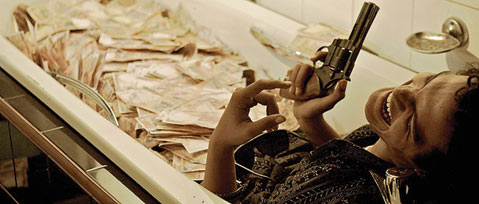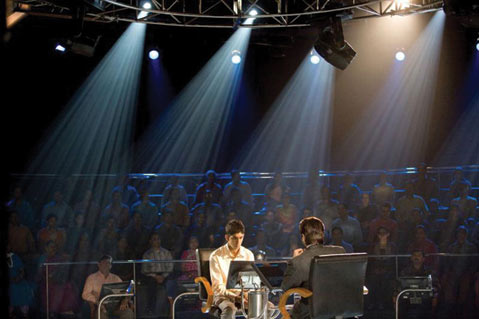Chatting with Danny Boyle, Director of Slumdog Millionaire
The Crafty and Nimble Exhibitor of Extremes

Come January 22, one film that’s a slam-dunk to be nominated for the Best Picture Oscar is Slumdog Millionaire. Imagine a Dickensian rags-to-riches fairytale set in Mumbai sprayed with darkness, squalor, and Bollywood splendor, but so dynamically photographed and executed that it feels totally brand new. This is a film that celebrates human resilience, the power of knowledge, and the importance of faith. Director Danny Boyle-who became known for lively fusions of style and content in such films as Trainspotting, Sunshine, and 28 Days Later :-has helmed one of the biggest critical crowd-pleasers of 2008, which just last week was awarded as best picture by the National Board of Review of Motion Pictures. I recently sat with the director to discuss his latest film.

One of the things I love about your film is all of the juxtaposed extremes: wealth and poverty, Islam and Hinduism, the city and the country, pain and joy. How hard was it to balance all these extremes? We didn’t really think about it because : [Mumbai] is like that. It’s constantly throwing all these jagged elements at you, some extraordinarily beautiful, some appalling moral horror. It fills your mind when you look at certain things, and they’re just side by side! I mean, absolutely side by side-there’s no attempt to separate them. : So when somebody says, “How can you do a film where you go from a kid being blinded deliberately to make him a better beggar to a Bollywood dance music number at the end?,” the thing is it’s not about going from one to the other, it’s about making sure both of them are in there because that’s the city. It would be fake to exclude either of them and it wouldn’t serve to make the trajectory between them too smooth.
You mix English and Hindi back and forth, and this mix makes the film very contemporary. Were you concerned about the subtitles? The Hindi stuff was sort of forced on us in one sense because of the little children not speaking English. But I’d always wanted it-again, it’s the portrait of the city. One of the wonderful things about the city is that you do hear so much English and it’s in a version called “Henglish,” this kind of mixture of Hindi and English. So you want to represent that as well. : I was talking to a screenwriter last night who is trying to write a film in Arabic and Hebrew about the shenanigans in the Middle East, and everybody’s making him write it in English and he says it’s fake.
The way that destiny-which you usually think of as part of old, classical stories-fits into contemporary Indian society was one of the things I just loved about the movie. Can you elaborate on that? I used to think destiny was a very passive thing [in India] and was explained by the caste system and people being kept in abject poverty. But actually, you get there and it’s much more complicated than that. And it’s very deeply embedded, even in a city like Mumbai, which, for instance, doesn’t exhibit so much of the caste system as the rest of India because it’s a relatively cosmopolitan city. But destiny still plays a big role. What’s amazing is that it’s to do with these extremes we were talking about as well-it links the extremes. They would build a tower block, a really posh luxury tower block, and around the bottom of it would be a skirt of slums, and the people who were building the tower block would live there with their families. In our cultures, once the building was finished, the slum would be cleared, if it was tolerated anyway. But it’s not cleared there-it’s left, because the destiny of the people who live in that building is closely and self-consciously linked with the destiny of the people who live at the bottom of it in the slum. So although we think [destiny is] actually limited in a way, it makes them quite liberated because they’re all combined. And they have this thing where life is everything, absolutely everything, and the city exemplifies it so completely in the way it lives its life. But life, as well as being everything, is nothing as well.

How did you shoot the opening sequence with the two young boys running through the streets and slums? It looks like a multimillion-dollar production, but I know it was done on a very small budget. Small, flexible cameras. This digital system we use will make your money go a long way by using imagination, by using passion, and going in with the right attitude to the slums. People were hugely helpful to us, to allow us to film there. You have to be crafty and cunning as well. We had two weeks’ rehearsal, and, because we were overseas, the equipment was already delivered. So I said, “No, c’mon, let’s go on and start filming.” And you can start filming, of course, because it’s digital so there’s no real costs involved. The camera crew is there anyway, supposedly preparing the equipment, when they’re just fannying around really, and I started saying, “No, we’re going out filming.” So we rehearsed for half the day and then we’d go out shooting the other half of the day. And if it’s rubbish, it doesn’t matter, nobody hears about it, but it allows you to build up some ambitious ideas about the chase through the slums.
There’s a scene in the [abandoned] hotel, which was originally written to be a fully working hotel. : We thought this would be a good place to shoot scenes as a rehearsal with the actors. If it didn’t work, it would be fine because we already had scheduled the main shoot in a proper hotel. It ended up working great and we got time back on the main schedule because we had saved a couple of days.
It’s stuff like that that requires you to just keep nimble on your feet. You’ve got to be crafty. I love that approach where you don’t have quite enough money, so you’ve got to be crafty like a beggar and go around gathering things, everything you can, to make the project better.
Speaking of being nimble, you have gone from genre to genre, reinventing yourself with every film. What’s that about? It’s an attempt to try to get back to the first time you make a film, to be honest. It’s the best time. You don’t really know what you are doing, you are not an expert, you are a kind of total novice, and it’s a wonderland, really, of trying to figure out how to do it.

Sort of like the characters in Trainspotting, wanting to re-create that first hit. Yeah, I’ve always tried to do that. As people put it bluntly, “You appear to swap genres,” but you don’t think about that yourself. You aren’t thinking, “Oh, which genre should I do next?” But you do inevitably, because you are trying to find that original moment again. You inevitably try to find challenges that you don’t quite know how to solve until you get on with it and solve it while doing it.
Last question, silly question: Who Wants to be a Millionaire is also featured in your earlier film Millions. Was that just a coincidence? You’re the first person to catch that. Yes, it’s true. : It just shows that these quiz and reality shows have saturated the culture. You cannot avoid them ever, anywhere.
4•1•1
Slumdog Millionaire is currently showing in Santa Barbara theaters.



